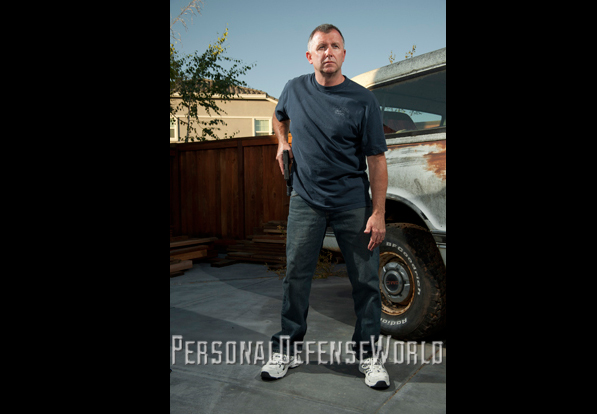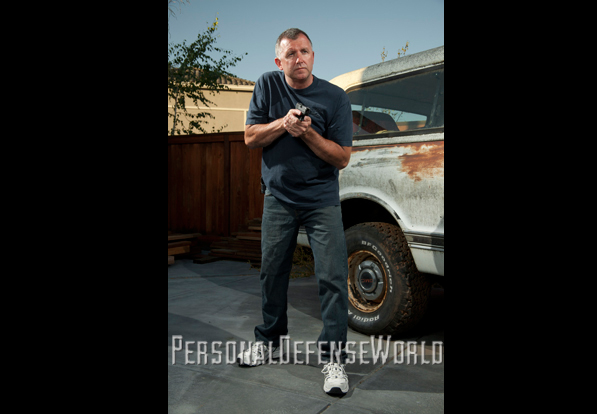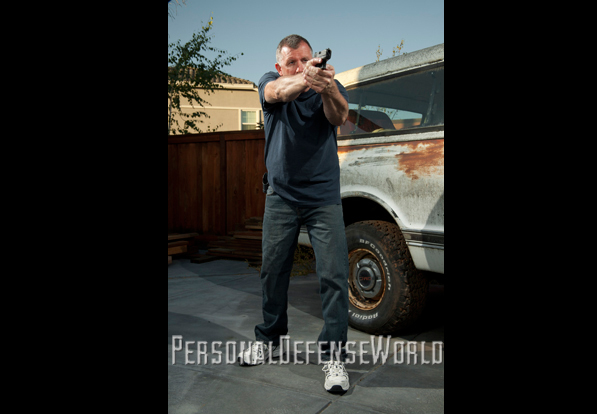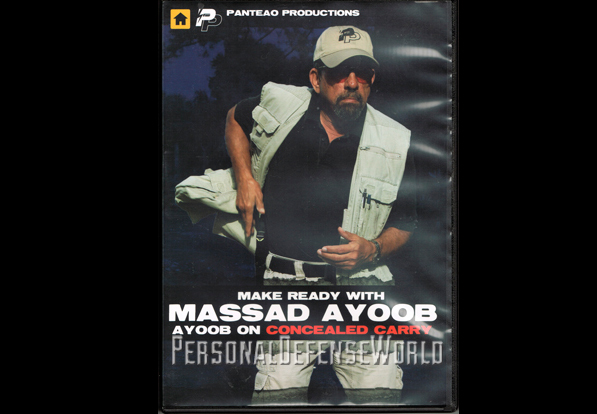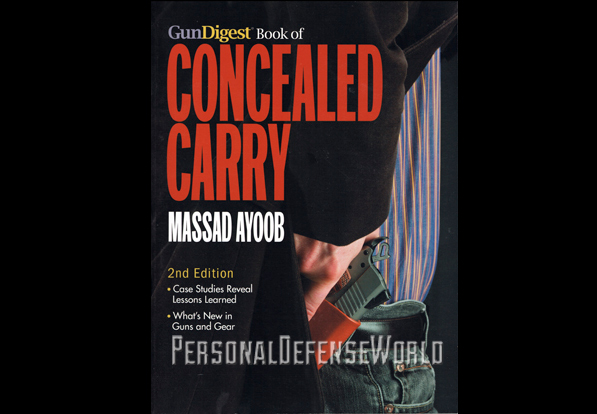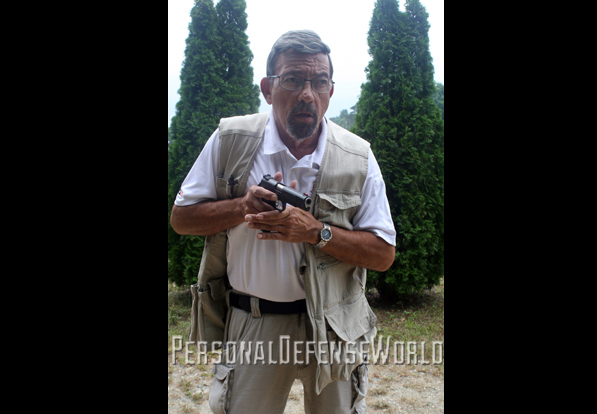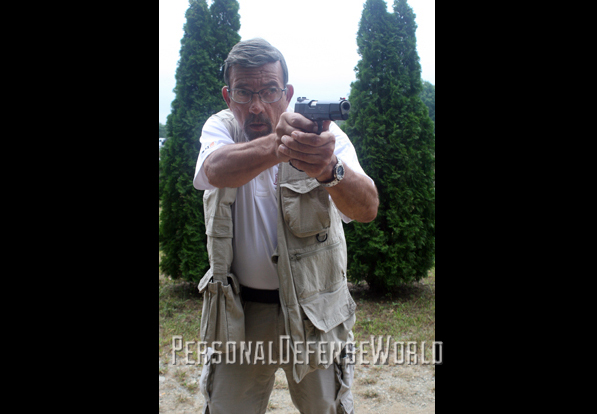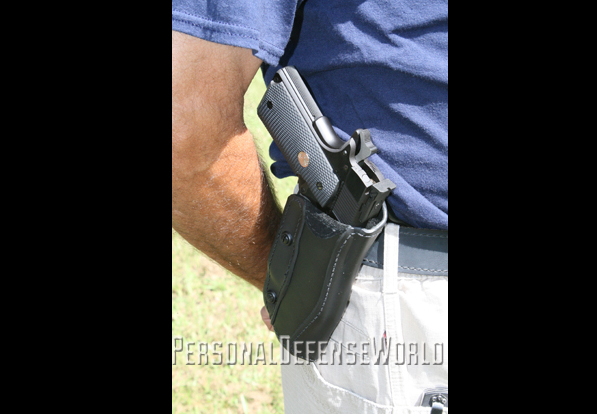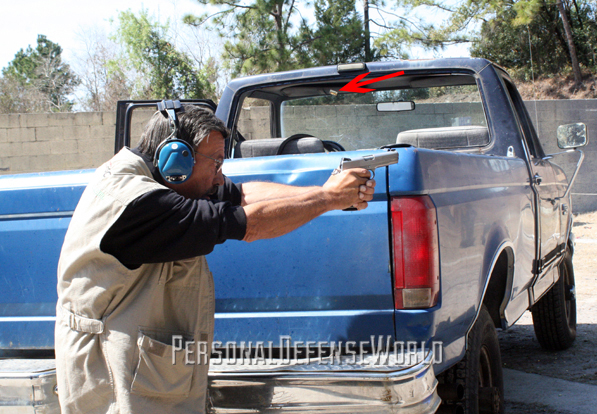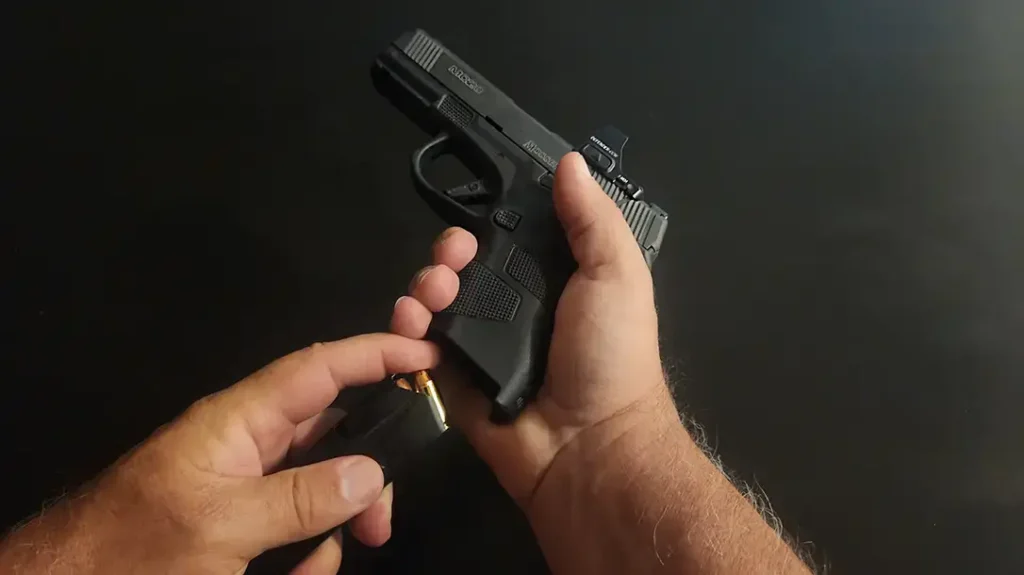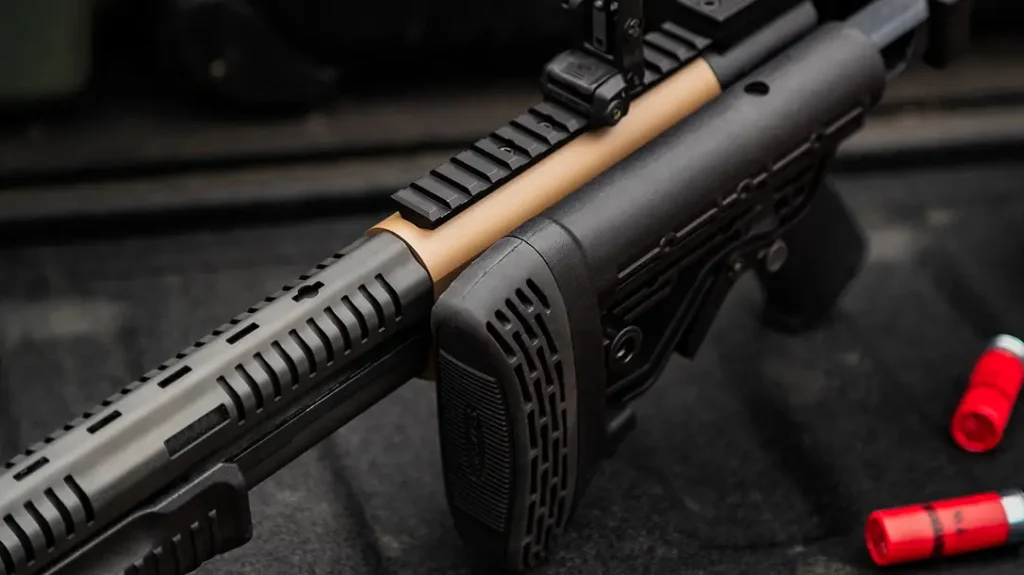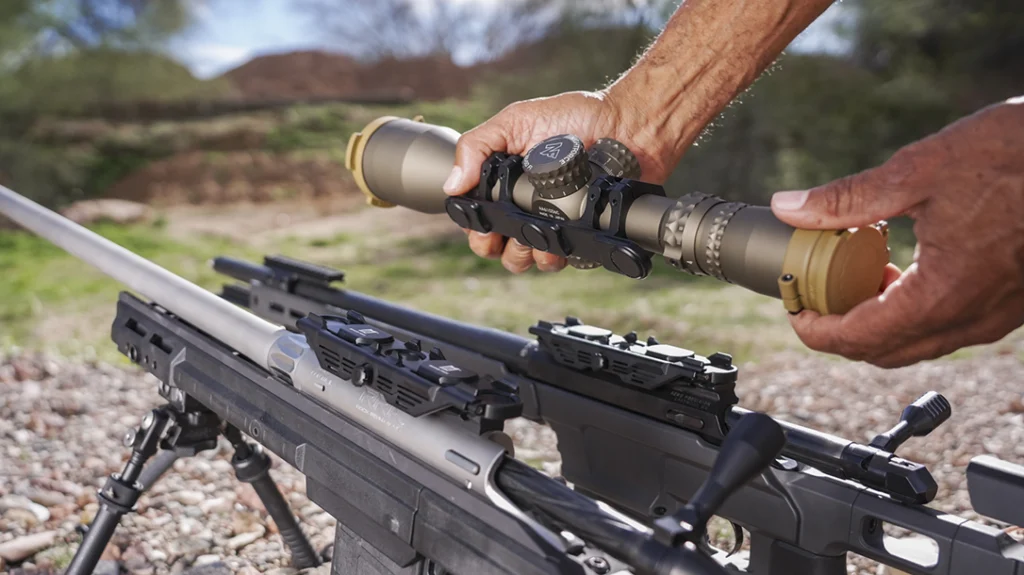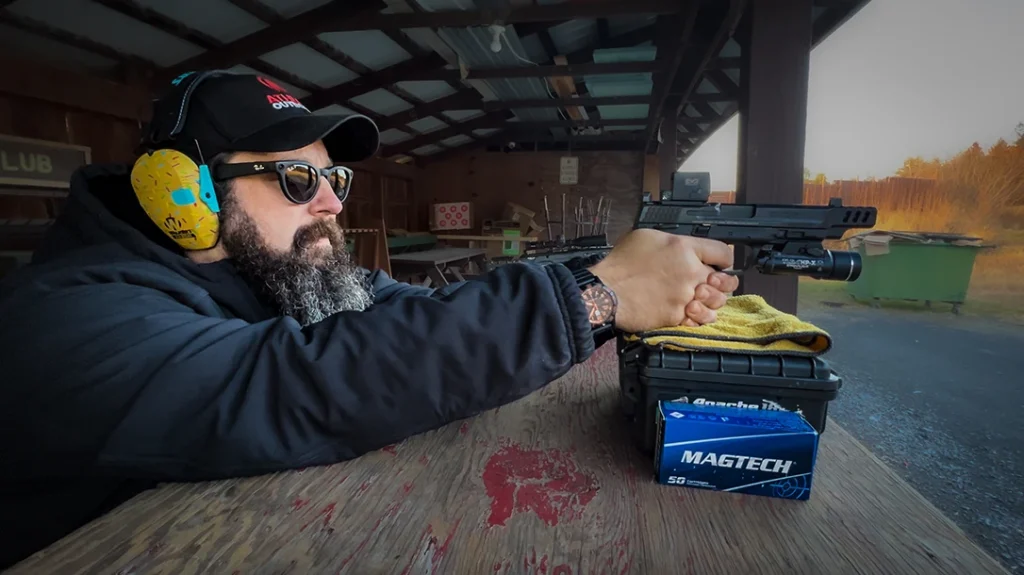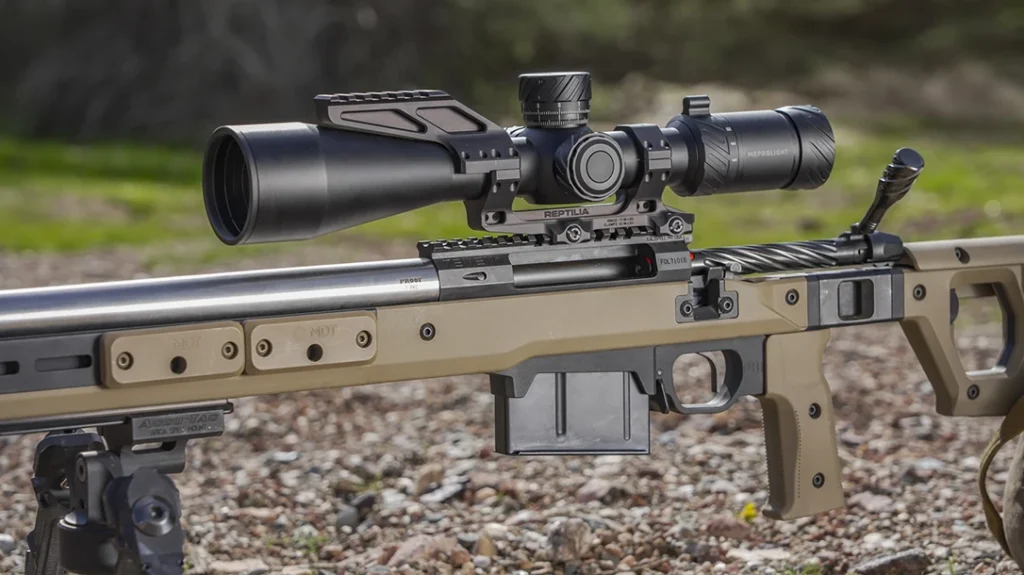More serious gun-carriers wear their weapons in belt holsters than any place else, and in turn, most of those carry at or just behind the strong-side hip. When the concealed quickdraw becomes a factor, one key question is inside the waistband (IWB) versus outside the waistband (OWB). In actually drawing and holstering, there are some subtle differences between the two styles, but in those functions they are really more alike than different.
In selection, these two carry styles differ more when it comes to comfort and concealment than in any other respect. Let’s take a look at those elements.
Concealment Vs. Comfort
I was a 12-year-old kid carrying a loaded Colt .45 in my dad’s jewelry store—legal in that time and place—when I first realized that a gun was a lot easier to hide inside the waistband than hanging off of a belt. There are at least three reasons why.
Advertisement — Continue Reading Below
One is that from the bottom edge of the belt, or wherever the holster loop secures to the belt, there is no gun or holster showing externally. This allows the concealing garment to ride up considerably higher (such as, for instance, when the wearer is reaching for a high shelf) without the sidearm or scabbard being revealed.
Another reason is that when the gun and holster are inside the waistband, the pants break up their outline. The third reason is that the belt, encompassing the holster from the outside instead of attaching on the body side, holds the holstered handgun tighter to the body. This greatly reduces outward tilting of the firearm.
It’s not hard to see the concealment advantages of IWB carry. What has to be experienced and felt to be fully understood, however, is the downside of the design: the comfort factor.
Advertisement — Continue Reading Below
Most of us have purchased our pants (or skirts, or kilts, or whatever) to fit us. Now that waistband has to contain us and a holstered firearm. Not surprisingly, things now get a bit crowded inside that waistline. Many new gun-carriers figure that the point of the hip is where they’re supposed to put the holster. That’s not a problem with a police uniform holster, which in modern designs will have an orthopedically curved shank to facilitate that carry position, and which rides on a wide Sam Browne or tactical nylon uniform belt that distributes the weight. Besides, a uniformed officer doesn’t need to worry about gun concealment. With a concealment holster, the OWB design is uncomfortable and conspicuously protuberant when placed on the point of the hip. It tends to chafe the hipbone at the ileac crest. IWB carry in that same location will still bulge more than it needs to, though not as blatantly as OWB, but it will rub brutally and mercilessly against the hipbone because the belt is pulling it tight there.
This is why those who carry concealed on the strong-side hip learn to put the gun slightly behind the hipbone, at “3:30” as opposed to “3 o’clock,” assuming a right-handed shooter and assigning the 12 o’clock location to the navel. This puts the holstered gun against soft tissue: much more comfortable for most, but also bringing the butt more to the rear and making a bulge more likely. Tilting the holster more forward, or simply choosing a gun with a shorter grip frame, will ameliorate this whether the holster is worn IWB or OWB.
The most important thing in the IWB comfort factor is to allow for the extra presence inside the waistband. We could, of course, lose some weight off the waistline area, but in modern America there are those who don’t consider this a reasonable expectation, and it’s no help for the person who already has a trim waistline. The logical thing to do is to simply buy pants a bit larger in the waistband. For most folks, that amounts to a waist size about 2 inches larger.
Advertisement — Continue Reading Below
There is an interesting side effect with that approach: When your lower body garments are 2 inches wider to accommodate the holstered handgun, the fit becomes sloppy and even uncomfortable when you don’t wear the gun. Therefore, those dedicated pants encourage you to wear the gun all the time. It keeps us honest, you might say, about being always armed and ready.
Most of us wind up with two wardrobes of pants: those that are sized for IWB carry and those that aren’t. When the latter are the order of the day, you’ll want appropriate OWB options. While paddle holsters are convenient for taking the holster on and off, their design pushes them farther out from the body and makes them distinctly more difficult to conceal. The best OWB concealment is afforded by designs with the belt loops outboard of the scabbard part that holds the handgun. The Alessi CQB, the Bianchi Black Widow, the Milt Sparks Roadrunner, the Ted Blocker 5B, the Aker FlatSider and the Mitch Rosen 5JR all exemplify this style, and they’ve all served me well. They conceal better because their design pulls the holstered pistol tighter to the body.
Two inexpensive holsters that let you try this style without heavy investment are the Don Hume JIT, available for a broad variety of concealable handguns, and the plastic Sport/Combat holster that Glock produces for its own pistols.
Advertisement — Continue Reading Below
Drawing Technique
There are many ways to draw a concealed handgun from the strong-side hip, but some work better than others. The “scoop draw” of Western quick-draw contests and old-school police academies has the hand coming up from below the gun butt. While this can be quite fast with an openly carried holster, it becomes awkward and fumble-prone when a concealing garment is draped over the holster and the gun it contains.
To start with, the drawing hand has to clear the concealing garment. With an open-front jacket or vest, I teach letting all the fingertips of the gun hand touch the torso at the midline of the abdomen, and then maintaining that contact as the hand sweeps back to the gun. The trailing edge of the little finger and the heel of the hand sweep the garment out of the way, bringing the hand to the pistol. The support hand is at the midline of the body, ready to receive the firing hand.
With a closed-front garment, such as a T-shirt or pullover sweater, the support hand should grab the bottom edge of the garment in front of the holster and pull sharply upward to the gun-hand shoulder, clearing the drawing hand’s path to the holstered sidearm. This technique is generally attributed to the great firearms/tactics instructor Ken Hackathorn.
Advertisement — Continue Reading Below
The firing hand comes down onto the gun, the web of the hand striking high into the grip tang of the autopistol or high on the “horn” of the revolver’s backstrap. The middle finger and the two below it take a firm, locking hold immediately, with the trigger finger straight outside the holster. If working with a holster like the BlackHawk SERPA with a push-button release, it’s important that the release button be pressed with the pad of your finger—not your fingertip—to keep the finger from entering the triggerguard prematurely.
Make sure the elbow of the drawing arm is pointed to your rear. This keeps the skeletomuscular support structure of your arm in line with the direction in which you’ll be applying force. Allowing the elbow to point out to the side, in what a martial artist might call a “chicken wing,” weakens your drawing movement and also makes it easier for an opponent close to you to physically stall your draw.
With IWB carry, the gun butt may be tighter and flatter against your side than with OWB carry. Make sure your fingertips dig between the inside grip panel and your body to take a firm drawing grasp.
Advertisement — Continue Reading Below
Now is time for the gun to come up and out. I recommend a “rock and lock.” The hand jerks the gun up sharply to clear it completely from the holster, and immediately rocks the muzzle up so it’s pointed downrange, toward the threat. The base of your thumb should be close to the pectoral muscle of your chest. Now the muzzle is already “on the threat,” and you can fire immediately if presented with a very fast-closing attacker at extremely close quarters.
From here, if there’s time, the gun arm thrusts straight forward toward the threat, bringing the weapon up into your field of view, whether you plan on coarse aim or a precise sight picture. As the handgun is extending forward, the support hand comes in from behind the muzzle and completes the two-hand grasp.
Holstering Tips
When inserting the gun into the holster, don’t probe for the holster mouth with the muzzle. This leads to the dangerous and amateurish practice of pointing the gun inward at your own body. The first few times, watch what you’re doing. The best way to learn to holster one-handed by feel, a useful tactical skill, is to “look it in” the first few times. This helps to teach the hand what it feels like to holster correctly.
Advertisement — Continue Reading Below
I teach holstering with the trigger finger straight (outside the triggerguard, of course) and with the thumb on the hammer or back of the slide. The straight finger prevents that digit from getting caught between the holster and trigger, which would cause an accidental discharge while holstering. The thumb on the hammer holds it back on a cocked-and-locked pistol, or safely down on a double-action one, creating another layer of “accidental discharge prevention.” With a 1911, Springfield Armory XD, or other pistol with a grip safety, it also activates that feature and provides yet another “safety net” against unintended firing.
Master shooter and firearms instructor David Maglio shows his students that if they bring their feet together and lean their upper body slightly away from the holster, it seems to minimize the degree to which the holster even crosses the lower body during the holstering process.
If you have a thumb-break holster, putting the gun straight down into the holster well can result in the muzzle being blocked by the strap. With that design, bring your elbow back a little further and let the bottom of the gun barrel or slide area start to enter the holster on a forward angle. Then, as you complete insertion, the top of the auto’s slide or the revolver’s frame separates the straps for you, making insertion much easier.
Advertisement — Continue Reading Below
There is a reason strong-side hip carry is so popular with off-duty cops and private citizens who legally carry guns. It simply works well. The choice between OWB and IWB is yours, but the more you work with it, the more likely it is that your choice will become IWB and OWB, as opposed to “either/or.”
